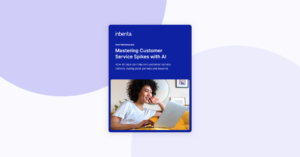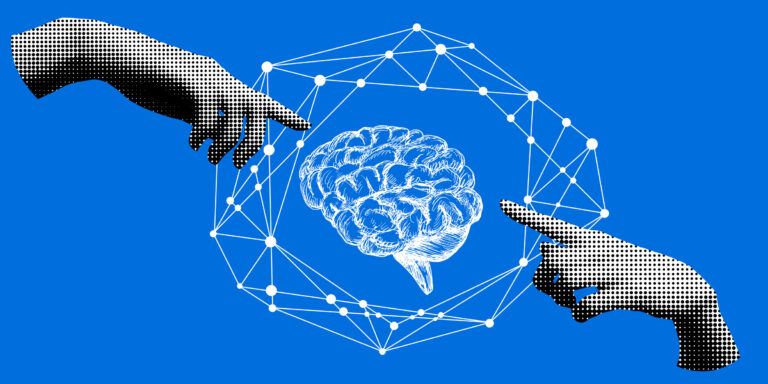Chatbots have become extraordinarily popular in recent years largely due to technological advances, but not all of them are created equals. From basic button-based bots to NLP-driven conversational chatbots, what differentiate them and most importantly, how can you design a qualitative conversational bot, that’s what we’ll see in this article.
What is a conversational chatbot? How does it differ from a regular chatbot?
A chatbot is a self-service tool that helps business automate a certain level of responses to frequent customer requests. While chatbots have been around for a while, most of them were button-based and offered limited interaction capabilities.
Conversational AI chatbots, on the contrary, are able to understand customers in the natural language they speak or type and suggest the best answer after analyzing the real intent and content of the request. This requires special Natural Language Processing capabilities that are quite advanced and that weren’t available in basic, button-based chatbots. These basic chatbots merely guided users through a predefined funnel, which not always provided the expected path or solution to customers.
Different types of chatbots
First and foremost, it is important to differentiate the various types of chatbots available in the market. From simple menu/button-based chatbots to conversational AI chatbots, they’re not equals as they can be using different types of technology. So let’s see what are the specificities of each of them.
Button/Menu-Based Chatbots
As the name suggests, these chatbots offer the user to choose from several options, presented in the form of menus or buttons. Depending on what the user clicks on, the bot then prompts another set of options for him to choose from and so on.
As you can guess, their structure is quite basic and therefore they represent a big bulk of the chatbots out there due to their simplicity. These bots can answer pre-defined questions and can help users navigate through a website or online webstore, thus facilitating their buying journey, but they quickly become ineffective when it comes to solving complex requests involving a lot of variables. Indeed, as soon as the user’s queries don’t fit in the pre-designed journey, this type of chatbot can’t be of any help, which ends up being quite disappointing and frustrating for the user.
Keyword-Based Chatbots
With this type of chatbots, the user types in a word or a phrase and the bot identifies the keywords in the query. It then uses a basic analysis engine in order to process those keywords and to match them with a pre-loaded response.
The advantage with these is that the bot will only reply with content that has been manually loaded into the system, nothing off-topic, thus giving your company good control over your brand’s automated messaging.
On the other hand, these chatbots are limited by the fact that they are not able to recognize misspelled words or slang. They are also highly contextual and consequently fall short when used outside of their context. Ask the question “book a hotel room” to a chatbot for a bookstore and it will likely return books about hotels.
Conversational Chatbots using NLP
These are by far the most advanced AI chatbots. They use Artificial Intelligence and Natural Language Processing in order to deliver the best experience possible to the user. Thanks to these technologies, the bot considers the different words that form the sentence, analyzes them as well as any available context in order to get a contextual understanding of a question. It can then apply that understanding towards the resolution of the query.
The main advantage of conversational chatbots using NLP is that they understand the meaning behind the words, which also means that they are even able to understand questions with misspellings, thus providing a great user experience.
Conversational chatbots’ various level of answers
But even if you’re planning on deploying, or already using, a chatbot using conversational AI technology, your bot can reach different “levels” of conversation. Let’s take a specific case as an example and explain what these different stages look like.
Let’s say your company has developed an NLP conversational chatbot that is used internally in order to answer employees’ questions about various Human Resources matters. A team member would like to know how many days of annual leave he has left and he asks the chatbot.
The first level of answer consists in telling the employee where he can find that information, typically on his payslip or on HR software. This is the most simple and basic level of conversation that can be reached pretty easily when deploying a conversational chatbot.
The second level of answer is slightly more evolved as the bot can redirect the employee to a specific internal system, like HR software in this case, where he’ll be able to find how many days of annual leave he still has owing.
Finally the third level of answer, which is much more advanced, allows the chatbot to automatically and seamlessly log the employee onto the HR software in order for him to directly access the information he needs. The bot can even prompt the employee to request some annual leave via a calendar or a form, without having to leave the chat platform. This stage obviously implies that the conversational chatbot can integrate with third parties platforms or softwares in order to be able to retrieve the information into another system. That’s one of the technological prerequisites for the bot to offer this type of interaction and service.
How to design a good conversational chatbot
Having a conversational chatbot using NLP technology is a very good start that will give your company a definite competitive advantage, but you also have to ensure that the interactions with your bot are qualitative and enticing for your users. So how do you design a bot that people will love talking to? Here are some tips and best practices to guide you in this delicate task.
A script for transactional queries
As the name suggests, a chatbot script is a scenario used in order to pre-plan conversational messages as a response to a user’s query. Keep in mind that not all queries will need a script: simple FAQ type of questions will be answered with a one-off response, but transactional queries will require a script. Indeed the bot has to follow a specific conversational flow in order to gather the details needed to provide a specific information such as a quote for example.
The script will obviously vary depending on the chatbot’s goals and the buyer journey, but keep in mind the following best practices when writing a script:
- Stay focused on the chatbot’s goals
- Keep messages short and simple
- Be as clear as possible in what you convey
Writing style
No matter the goal of your conversational chatbot, you have to ensure that people understand it. This means that every response given by the bot must be clear and free of any ambiguity that could lead to misinterpretation.
While it can seem quite obvious, too many companies or Botmasters forget about this one and simple rule. It results in a conversational interface that is more confusing than helpful, which completely defeats its purpose.
But in addition to writing a clear and unambiguous script, you must also keep your bot’s answers as short and concise as possible. And the reason for this is quite simple: the more there is to read, the higher the chances of people getting confused, tired and distracted. No matter how meticulous your writing is. A good way to achieve this is to break the dialogue up, ie dividing your messages into smaller chunks.
Personality
Personality is the flavor of your bot. Indeed, you have to define what kind of personality you want your conversational chatbot to have in order to determine its tone of voice, what kind of language it will use, its communication style, etc.
But crafting a likeable character is a tricky balancing act. Give it too little personality and the interaction feels dull. Overdo it and it quickly becomes annoying…
You get it, crafting a quality conversational chatbot is not an easy task, but we hope that these tips and best practices will be of help when it comes to deploying your very own bot.












